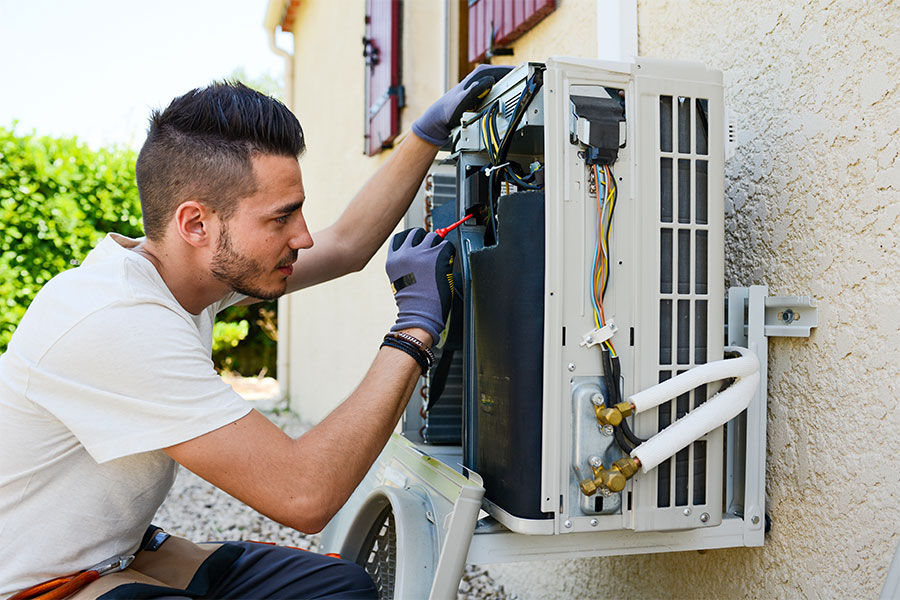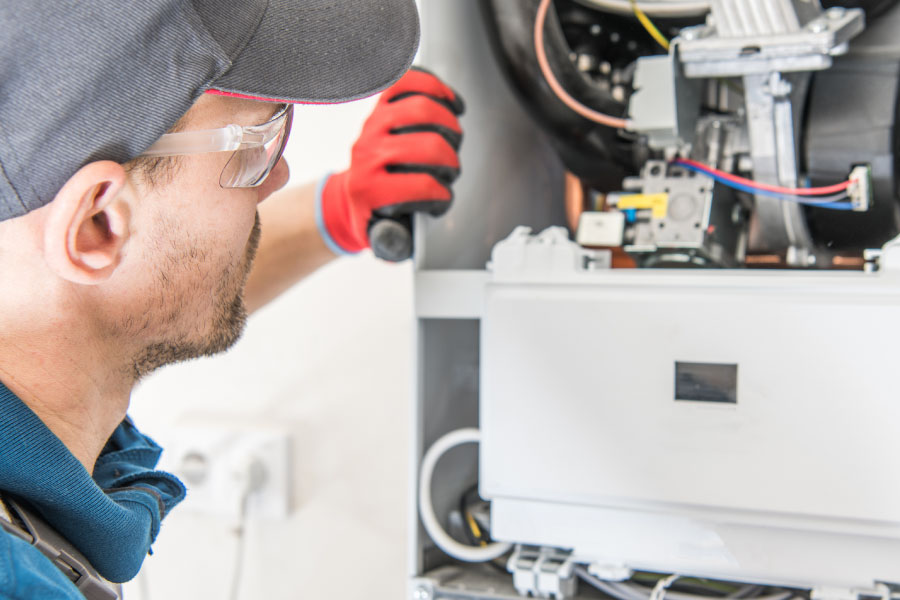
Heating and Cooling Solutions
The days are getting longer, the grass is greening up, and you can comfortably venture outside with fewer layers: it must be springtime in Montana! As you’re enjoying the warmer weather and planning for the summer, take time to prepare your home’s air conditioner for prime cooling performance. Spring is the perfect time to schedule any air conditioner repair service so your A/C unit is summer-ready and you don’t have to face longer wait times for an HVAC repair technician in June, July, and August.
The quick transition from heating in the winter to cooling in the summer can, sometimes, shock your HVAC unit and reveal any lingering issues in your air conditioning system. Often, these issues can cause your air conditioner to break down. By scheduling any necessary air conditioner maintenance or repair services early in the spring season, you can be confident that your system will be ready to keep your home cool and comfortable all summer.
In fact, getting your home’s HVAC unit professionally maintained twice a year, at the beginning and end of each summer season, may increase the lifespan of your unit by five years. A maintenance appointment includes a professional walkthrough and cleaning by one of our highly trained technicians. We will proactively diagnose and address any needed repairs quickly and cost-effectively, ensuring that your HVAC unit runs smoothly when things heat up.
Are you wondering if you need air conditioner repair services or seasonal air conditioner maintenance? We recommend turning the unit on for a short run during one of the first warm spring days of spring and watching for any of the warning signs indicated in the below checklist. If you notice something amiss, call Mountain Heating and Cooling at (406) 586-4007 or schedule an appointment online—our Bozeman air conditioner repair experts are here to help!
Checklist: 6 Signs You Need Air Conditioner Repair Services
1. The A/C system is blowing warm air
If you’re running your air conditioner and there’s warm air coming out of your vents, start by checking the thermostat to make sure it’s set to cooling mode. Then set the temperature so it is lower than the ambient temperature of your home. If the air conditioner is still blowing warm air, it could point to a compressor issue or restricted airflow somewhere in the unit or vents.
2. The airflow is weak
If your vents are barely pushing air, it might mean your air conditioner’s air filter is clogged or the motor is broken. Insufficient airflow can come from several other issues too, so contacting a professional HVAC contractor right away is key to addressing and resolving any problems.
3. The A/C unit is making noises
Most units make a little more noise as they cycle on or off than they do when they are in their cooling cycle. But if you hear grinding, squealing, rattling, or scraping sounds, it might mean a loose part or another issue. The complex nature of these units means that one broken part has the potential to cause damage elsewhere, so “listen” to this sign that it’s time to schedule air conditioner repair services.
4. There is a strange smell coming from the vents
If the air coming from the vents in your home has a burning or musty smell, it might mean your air conditioner needs some fine-tuning or the unit and vents need a thorough cleaning. Proper air conditioner functioning is essential for the health of your unit, and clean air is vital for your and your family’s health.
5. Puddling or humidity
An A/C unit should actually de-humidify your home, and the condensation has to be removed from your home through pipes or tubes. Over time the condensation removal route can become blocked or kinked. Watch for moisture either near the indoor furnace or air handler. Pooling of condensation around the indoor unit may indicate a blocked tube or leaking condensation from the coil. In this case, you’ll want to contact a professional immediately and turn off the unit because as long as you’re cooling you will create more condensate and have the risk of creating water damage.
6. The thermostat isn’t working
Sometimes, the problem isn’t the A/C unit—it’s the thermostat. A broken or malfunctioning thermostat might cause obvious issues, like air temperature that’s way off from the thermostat setting, or it could be more subtle, like an HVAC zoning system that isn’t accurately controlling different rooms or areas as expected. Whatever the problem may be, our technicians can quickly diagnose, recalibrate, or repair your thermostat.
Your Trusted Team for Bozeman Air Conditioner Repair Services
If you noticed any of the previously mentioned warning signs, it’s time to schedule a repair. We recommend scheduling air conditioner repair services or seasonal maintenance early to make sure everything is running well when it matters most. Should any issues arise, we are here to help address any emergency repairs.
If your air conditioner is beyond the point of repair and you are considering upgrading your unit, our Bozeman air conditioner installation team can walk you through the process of selecting the best HVAC system for your home, budget, and lifestyle. Our highly trained technicians will travel to your home in the Gallatin Valley, Belgrade, Park County, and beyond.
Let us help you get ahead of the summer heat. Reach out today to schedule your seasonal A/C appointment with Mountain Heating & Cooling.

Heating and Cooling Solutions
We rely on our furnaces to keep us safe and warm throughout the long winter months, but emergency furnace repair services can pop up from time to time. When temperatures drop below zero and snow drifts start to pile up, a functional, dependable furnace is a lifesaver. But a malfunctioning furnace or HVAC can put us (and our families) in potentially life-threatening situations—from house fires to carbon monoxide poisoning.
In general, furnaces are totally safe, and safety issues are rare. However, occasionally, a furnace problem can arise and lead to more serious emergencies that can cause some damage to your wallet, health, and home. Fortunately, there are “symptoms” to watch out for. We created a list of five warning signs that you may need emergency repair services. If you notice any of these issues, call our team for an emergency furnace repair to keep your home safe and toasty warm. Our team specializes in Bozeman HVAC repair services, and we can help quickly diagnose and resolve furnace emergencies. In case of an emergency, contact us here or call our Mountain Heating & Cooling team at (406) 586-4007.
5 Signs You Need an Emergency Furnace Repair
Sign #1 — Your furnace is running improperly
Is your furnace cycling too quickly, turning on and off when it should run more continuously, or not shutting off the fan? Maybe your furnace is only blowing cold air or won’t turn on at all. If these problems are not being caused by a thermostat setting issue (like the fan being set to “on” rather than “auto”), it’s time to call an HVAC repairman. A professional can quickly diagnose and fix the issue, whether it’s a mechanical problem, an electrical failure, a thermostat issue, or something with the furnace itself.
Sign #2 — There’s a strange or unpleasant smell coming from the furnace or vents
A musty or “off” odor could be caused by a simple issue with an easy fix, such as replacing the air filter or getting the ducts cleaned. But smells like smoke, rotten eggs, burning plastic, metal, or chemicals are often signs that it’s time to reach out to an emergency furnace repair professional.
A Rotten egg or a sulfur-like smell is a major indicator of furnace issues since this smell often indicates a natural gas leak. Because natural gas is odorless, gas companies add a harmless chemical called mercaptan to ensure leaks are easy to detect. Natural gas leaks can cause fires or explosions with little warning. So if you smell this odor, leave the house with your family and pets right away, and don’t turn lights on and off or plug things in (sparks can be dangerous with this combustible gas). Once you’re safely away from the house, call your utility company and the fire department, and they will tell you what to do next.
Other smells may indicate major furnace issues but don’t carry as much immediate danger. For example, a metallic smell might mean your furnace is overheating. If you smell a burning metallic odor from your furnace, turn it off and call an HVAC repair technician. A chemical or formaldehyde-like smell could be a sign of cracks in the furnace’s heat exchanger. Contact a professional HVAC repairman immediately to ensure there’s no risk of carbon monoxide poisoning or other issues.
Sign #3 — The furnace has a yellow or orange flame instead of blue.
When a natural gas furnace is functioning correctly, the pilot light will appear blue. Efficient combustion creates a hot, blue flame, often with a light blue triangle at its center. This indicates that a furnace is in good working order with complete gas combustion.
If a pilot flame is yellow or orange, that can indicate incomplete or ineffective combustion. This might happen with an older furnace nearing the end of its lifespan, or it might just mean a furnace is due for a cleaning, part replacement, or repair. Sustained yellow or orange flames can indicate the possibility of a carbon monoxide leak. In these cases, it’s best to turn off your HVAC system and contact a Bozeman HVAC repairman.
Sign #4 — You notice puddles, steam, or condensation around the furnace
Is your furnace creating steam, condensation, or pooling water? Any of these symptoms mean that the furnace or boiler has sprung a leak or has a valve issue. A properly functioning furnace will not create condensation—modern furnaces use cooling exhaust to increase their energy efficiency, and the moisture gets vented away before it has a chance to condense and pool up. But a puddle means it’s time for furnace repair. Typically, this type of issue can be easily resolved, but if it traces back to the heat exchanger, it can be a more serious problem.
Sign #5 — A carbon monoxide detector is going off
Any time a carbon monoxide detector goes off, it’s vital to pay attention, take it seriously, and take safe action. If ignored or unnoticed, carbon monoxide can cause sickness and even death. Every year, it kills hundreds of people and makes thousands of others ill. If your detector has been triggered, it may be due to any number of issues—whatever the cause, it’s critical to get the problem addressed immediately and schedule an emergency furnace repair.
Your Trusted Bozeman Heating and Cooling Specialists for Emergency Furnace Repair
When your furnace is malfunctioning or you notice any of these warning signs, we recommend reaching out to the professionals immediately. Scheduling emergency heating repairs is more than a matter of comfort and convenience; it’s key to keeping you, your family, and your house safe.
We recommend seasonal HVAC checkups and routine cleanings to help prevent furnace emergencies before they happen. With all home systems, it’s normal for equipment and components to deteriorate over the years, but proactive maintenance can help prevent avoidable failures. If you are wondering if your furnace is due for a checkup, reach out to get scheduled with a pro from Mountain Heating & Cooling.
Our experienced Bozeman HVAC repair technicians specialize in accurately diagnosing and repairing all types of furnace issues. Mountain Heating & Cooling works hard to provide prompt and professional service — because should an emergency arise, you deserve the peace of mind that you’re well taken care of. We are always here to help with any issue, large or small.

Heating and Cooling Solutions
Whether you’re shopping for a furnace for the first time, looking for an upgrade, or just exploring your options, it can feel overwhelming to know where to start. We’re breaking down the differences between single stage vs two stage vs variable speed furnaces to help you decide which is best for your home.
Topics
Single Stage vs Two Stage vs Variable Speed Furnace — How Do They Work?
To understand the difference between your single stage vs two stage vs variable speed furnace options, it’s helpful to know the basics about how a furnace regulates temperature in a home.
A furnace’s capacity is measured in BTU output, otherwise known as heat output. Your furnace’s capacity is based on the coldest days in your region. If you live in a cold area, as we do here in Montana, your home will (or need) a furnace with a higher capacity. Some furnaces run only at 100% capacity—they operate at full capacity for a few minutes, then cycle off, then cycle back on again. Other furnaces can operate at different capacities, allowing them to blow air that’s “hotter” rather than “hottest.” A furnace is classified as single stage, two stage, or variable speed based on how many power levels it can run.
Pros and Cons
Single Stage Furnace
A single stage furnace is the simplest type of furnace with just two settings: on or off. That means it runs at full capacity or not at all.
Pros
A primary advantage of a single stage furnace is the lower price point. Single stage furnaces have simpler communication needs, so the cost for smart thermostats can be less.
Cons
One of the drawbacks of single stage furnaces is that when they are used to heat a large or multistory home the ambient air temperature can vary widely by floor. Because the furnace operates at full capacity for every cycle, the air temperature nearest vents warms up faster than areas further away. The challenge is the location of the thermostat in relation to the varying temperatures of the rooms throughout the house. The thermostat might “think” the entire house is at the temperature you’ve selected on your thermostat and shut down the furnace cycle too soon, leaving cold spots and even cold rooms further away from the vents.
In addition, a single stage furnace starts blowing at full blast as soon as it turns on. While it heats areas quickly overall, some air that’s not fully warmed is blown into your living spaces at the start of each heating cycle. The noise of this fan speed, particularly in a poorly-designed duct system, often can cause a need for higher TV volumes or dinner conversations. Since they only operate at one level, single stage furnaces tend to use power less efficiently—the same as if you were to only drive your car at 100mph versus cruising the highway at a gas-friendly 75mph. The START/STOP of the fan is particularly efficient.
Two Stage Furnace
Two stage furnaces, also called dual stage furnaces, have three settings: low mode, high mode, and off. Two stage furnaces typically run on low mode and kick into gear only when the weather is cold enough or it needs to create more heat to accomplish a large gap from the current temperature to the requested thermostat set point. On milder days, two stage furnaces decrease their output from 100% BTUs to a lower setting, adjusting both the amount of energy being used and the blower fan intensity. The result is that they can run longer and maintain a thermostat setting with more accuracy. They also boast improved efficiency and quieter fan heat and cool cycles.
Pros
Along with efficiency, accuracy, and quieter cycles, an added benefit of two stage furnace systems comes from the longer runtime. The longer runtime moves more air through the filter throughout the day, cleaning out allergens, dust, and other debris. What this means is that it creates more comfort in a wider range of rooms in your home.
Two stage furnaces typically cost more than single stage, but for a good reason. They can warm a larger or multistory home much more evenly, consistently, and with better cost-efficiency. A more significant investment here can significantly lower your heating bill in the long run.
Cons
Two stage furnaces are generally a solid choice for most homeowners, but they cost more than single stage. They also will require a new thermostat if you are transitioning from a single stage furnace in order to control the additional low-to-high fan options being added to your home.
Variable Speed Furnace
This is the most comfortable and efficient of the three furnace styles. Similar to two stage furnaces, variable furnaces can cycle at different capacities for the highest possible comfort level in your home.
Pros
If one stage makes a home comfortable, and two stages make it even better, multiple stages can create true luxury, with steady temperature and even heat—no cold or hot spots throughout the home, and no spikes in temperature throughout the day. Depending on the model, variable furnaces can produce heat at anywhere from 100% capacity to as low as 40%.
With a variable speed furnace, you will never be limited in your future choices for air conditioning, zoning, or air filtration. A variable speed furnace can work with a single speed air conditioner, provide year-round comfort for your home, allows for more consistent air flow throughout the home, and provides better air filtration.
Cons
The drawbacks of variable furnaces are primarily in their price point. You’ll want to make sure you choose a reputable contractor who’s able to set up the furnace controls so you reap the benefits of the furnace. We’ve often gone into homes where customers have a top-of-the-line furnace with a thermostat that was miswired or not programmed to match their variable speed furnace.
How to Choose Which is Best for You
Single stage furnaces are a good choice for budget-conscious buyers heating a small to medium-sized, single-story home. These furnaces are simple and highly reliable, heating your space with less of an upfront investment on equipment.
Two stage furnaces increase the comfort and efficiency factors, making them an excellent midrange option for larger or multistory homes. These furnaces can help decrease heating bills with more consistent ambient temperature from steady, warm airflow.
Variable speed furnaces are the highest efficiency models, heating a household with fine-tuned capabilities. These are investment pieces that deliver predictable returns when it comes to maximizing comfort and are less of an investment in the monthly costs of heating and cooling your home.
Choosing between a single stage vs two stage vs variable speed furnace will depend on your budget, the size of your home, and your desired comfort level.
If you’re still considering your best option for Bozeman furnace installation, Mountain Heating & Cooling can help. As your local HVAC experts, we understand the heating needs of homeowners in the Gallatin Valley and beyond. We specialize in Trane furnace installation and servicing, helping you take advantage of the most reliable, high-quality HVAC systems on the market. Whether you’re looking for a Trane single stage furnace, a two stage model, or a variable speed system to heat your home, we’re here to help you navigate the decision with confidence. You can depend on our friendly, respectful team with extensive HVAC training to deliver the quality service you and your family deserve.
Reach out to our team today with questions about choosing a furnace for your home, or schedule an appointment with our team. We’re here to make your home safe and comfortable year-round.

Heating and Cooling Solutions
Bozeman is growing, and with that growth comes new construction. From residential to commercial construction and remodels, every successful project depends on specialist expertise to deliver great results. HVAC installation is part of every build. However, not all HVAC contractors are the same.
Are you looking to hire a Bozeman HVAC contractor for your remodel or construction project? Our Mountain Heating & Cooling team has put together a list of essential questions to consider to help you confidently hire skilled, reliable, and professional Bozeman HVAC contractors (and avoid bad contractors that lead to additional time, money, or headaches).
5 Red Flags to Watch Out for When Hiring an HVAC Contractor
Red flag #1: They’re a one-person show
While a one-person company may claim the benefits of being nimble, flexible, and adaptable, the truth is one person has limited bandwidth compared to a team of technicians. It’s harder for a single contractor to be available should any issues come up at the last minute. And even if they’re brilliant and experienced, every project benefits from a variety of talent, experience, and diverse skill sets. The quality of an install is driven by the utilization—and understanding—of new, emerging technologies, so it’s hard for a single person to stay on top of the evolving market.
Green flag: They’re a dedicated team with the benefits of greater bandwidth, a customer service contact, and multiple areas of expertise.
Red flag #2: They’re not licensed, insured, or certified.
A solid, reputable HVAC contractor shouldn’t hesitate to provide you with proof of insurance and licensure. When it comes to HVAC service and other home maintenance, a lack of insurance can escalate issues like property damage and injury into major liabilities. If your HVAC contractor isn’t insured and licensed, they’re not guaranteed to know and follow building codes, which exist to protect you, your family, and your home.
While certifications aren’t necessary, they show continued education to gain broad and specific subject-matter expertise.
Green flag: A good HVAC contractor will be proud to highlight their certifications, and they’ll definitely provide proof of licensure and individual and business insurance coverage.
Red flag #3: They have bad reviews or no references.
Bozeman may be growing, but it’s still an interconnected community. Personal relationships are key. References establish personal and professional reliability and give you a picture of past work successes or hiccups.
Ideally, you’ll be working with a company with at least some online presence, such as a Google Business Profile, Facebook business page, or even Yelp or Houzz profile. Check out their online reviews. Note that all businesses, even the best ones, will receive a negative review once in a while. But too many low opinions add up to signal lingering issues.
Pay attention, in particular, to whether the same complaints come up in multiple reviews. Did the company respond to their negative reviews? What did they say? Don’t be shy to bring up negative reviews with the company directly. There are always two sides to the story, and a company with transparency about past mistakes or issues could be even more trustworthy and valuable to your project than one with a seemingly squeaky-clean online reputation.
Green flag: They offer easy-to-contact professional references, and you can find positive reviews of their company online.
Red flag #4: They have poor communication.
In our hyper-digital world, tradespeople may be some of the few who aren’t connected to the web 24/7. For example, when you’re elbow-deep in a complex furnace installation, you don’t want to be distracted by emails. If you choose your HVAC contractors well, they’ll have a dedicated team member who handles scheduling and communication, meaning someone will always be available to get a technician to your home. But if a company shows lengthy delays in their response times with no explanation or only offers vague explanations of quotes, pricing, or services, that may be your sign to look elsewhere.
Green flag: They communicate promptly, proactively, and professionally.
Red flag #5: They have an extremely low quoted bid.
Are you comparison shopping? Competitive bids are one thing, but outlier lowball cost estimates are a sure red flag. Remember: if it seems too good to be true, it usually is. A very low bid may only be possible through very low overhead—e.g., a company may not invest in quality equipment, dedicated staff power, or experienced HVAC technicians.
Green flag: Their bid is attractive but within the range of reasonable.
Contact Our Team for Reliable HVAC Contractors
The bottom line is that no matter the scope of your HVAC service needs, working with good Bozeman HVAC contractors pays dividends. At Mountain Heating & Cooling, we are proud to provide quality, trustworthy service at every step—from installation to communication. Please reach out to us to discuss your project needs!

Mountain Heating & Cooling News
Is your home’s HVAC system making your life simpler or adding to your to-do list? Imagine that you’re heading out of town to a business meeting or on the highway onramp with a carload of kids on the way to a soccer tournament. But you accidentally left the heat or AC on full blast. The last thing you want is to step into a cold house when you return home or expend excess power that skyrockets your monthly energy bill. Life is busy enough, so you shouldn’t have to worry about your home being comfortable when you’re there and taken care of when you’re not.
Luckily, home automation means you can easily and automatically control the temperature in your home anytime and from anywhere. New home automation technologies give you freedom, control, and peace of mind in knowing that your home will always be at the right temperature. Plus, automation helps you save money on heating and cooling bills. As your Bozeman home automation experts, Mountain Heating and Cooling can make your home comfortable—and your life easier—with HVAC-friendly smart home technology. Read on to learn more about home automation or schedule an appointment with our experts today.
Check, Change, & Schedule Your Home Temperature from Anywhere
Did you know home automation can include your HVAC systems? Home automation systems can monitor and control your home furnace and air conditioning unit using a centralized smart thermostat. Most smart thermostats also tie into a smartphone or tablet app, so you can check, change, and preschedule the temperature of your home while you’re on the go. As the seasons change in Bozeman, home automation with HVAC control adjusts the air temperature inside your home. That way it’s always comfortable when you or your pets are there, and optimizes your energy usage when you’re away.
The Benefits of Home Automation
1. Smart Scheduling – Smart scheduling lets you fine-tune your HVAC’s operation schedule. For example, you can schedule your thermostat to start heating up at the right time to ensure it’s warm and cozy when you get home on cold winter evenings. During weekdays, you can automatically lower the temperature when you’re out, saving energy and cutting your heating bills.
2. Energy Tracking & Reporting – Automation also provides ongoing and annual system performance reports. This helps you optimize your heating and cooling schedules and reduce your home’s energy consumption and costs.
3. Smart Zoning – If you have Smart Zoning capabilities in your home, automation allows you to set different rooms to different temperatures. Don’t spend much time in the spare room or shop? Schedule your thermostat and smart vents accordingly so those rooms get less heat.
Where to Start with HVAC Automation
What HVAC systems can be included in your Belgrade or Bozeman home automation? You don’t need to take on an entire HVAC installation project to enjoy the benefits of home automation. We recommend starting simple with an easy thermostat swap.
Smart Thermostat Benefits
Regular thermostats allow you to adjust your home’s air temperature via a wall-mounted control panel. Smart thermostats, on the other hand, provide much more control and versatility than raising and lowering the air temperature by a few degrees. Although they still have a touch-based interface, they also allow you to make changes remotely through an app while automatically accounting for your daily and weekly schedules, where in your home you spend your time, and what temperature you’d like for different times of the day. In addition, smart thermostats offer insights into your home energy use patterns, giving you recommendations and updates on how to conserve energy while keeping your home perfectly comfortable.
Which Smart Thermostat is Best?
We are proud to help our customers choose and install the most innovative, energy-efficient products, reliable enough to take on the Big Sky State’s toughest weather conditions. As your trusted Bozeman home automation team, we offer a wide range of smart thermostats, including Trane® Home (previously Nexia™) that streamline home automation and let you connect from anywhere.
In addition, they give you integrated access to any other important smart systems you have installed like home locks, lights, and cameras. Trane and Nexia are compatible with all smartphones, Google Home, and Alexa. The Trane app also creates a two-way communication channel between you and your home furnace, so you get alerts to your phone or email (and your HVAC service provider gets notified) if your system needs repair. Once you have a smart thermostat, you can upgrade to other “smart parts” one at a time.
Contact Our Bozeman Home Automation Experts
A professional HVAC installation for your Bozeman home automation systems can provide peace of mind. With Mountain Heating & Cooling, you know your smart home systems will function reliably, supporting you and your family’s busy lifestyle by providing control and comfort you can count on. Reach out to us today for a home automation consultation.





